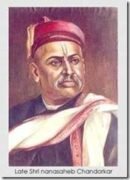SITA’S SACRED DEFIANCE
Das Ganu, Dhumal, and Booty were away from Shirdi to make a pilgrimage to Prayag, Gaya, Ayodhya, and Varanasi. After their return, they shared their experiences.
 Baba was delighted to learn they were paying homage to their ancestors. Suddenly when Dhumal was referring to Gaya, Baba referred to a little-known anecdote from the Anand Ramayan, Tirth Yatra Kanda. This is a story of Sita’s curses and blessings at Gaya. Baba had a smile, but Das Ganu explained in detail.
Baba was delighted to learn they were paying homage to their ancestors. Suddenly when Dhumal was referring to Gaya, Baba referred to a little-known anecdote from the Anand Ramayan, Tirth Yatra Kanda. This is a story of Sita’s curses and blessings at Gaya. Baba had a smile, but Das Ganu explained in detail.
During their forest exile, after the demise of King Dasharatha, Rama with Lakshmana, and Sita reached Gaya through the forest and wanted to perform the ritual known as ‘Shraddha’ for his father. While Rama and Lakshmana went to procure the ritual necessities, Sita waited on the banks of the Falguni River.
Since it was getting late and the sun was setting, King Dasharatha in spirit form, expressed his concern about the rapid passing of the auspicious hour, and demanded that she begin the ritual. Sita tried to defer, as traditionally, women don’t perform shraddha, and suggested that they wait for his sons to do the needful, but Dasharatha insisted. Finally, Sita gave in and arranged for the ‘Pinda Daan’ herself.’ Pinda’ is an offering of a rounded ball of rice, dotted with sesame seeds, considered as a way to salvation for the departed soul. Using a mound of sand, Sita invoked nature and creatures such as the Falguni river, a cow, a crow, a basil plant, a Brahmin, and a banyan tree as witnesses who would testify to her sincerity.
When Rama and Lakshmana returned and saw this, they were surprised and questioned Sita. She explained her urgency and invoked her witnesses. But much to her surprise, all of them remained silent except for the banyan tree.
An angry Sita then issued her now famous curse, ‘Sita Shraap’ against the river, which was to remain dry, against the cow, crow, basil plant, and the Brahmin.
Das Ganu explained that this episode exemplifies Sita’s unwavering commitment to her dharma and her determination to uphold her responsibilities, regardless of societal norms. It challenges gender norms and emphasizes Sita’s pivotal role in shaping Ramayan’s events.
To delve deeper into the notion of women’s agency within the Indian sacred tradition, Das Ganu  sought Baba’s approval to turn to this episode from the Ananda Ramayana as a source. It serves as a poignant example of how women actively participate in rituals and decisions that may not be conventionally associated with their gender, highlighting their agency and contributions to India’s spiritual space.
sought Baba’s approval to turn to this episode from the Ananda Ramayana as a source. It serves as a poignant example of how women actively participate in rituals and decisions that may not be conventionally associated with their gender, highlighting their agency and contributions to India’s spiritual space.
Nana Saheb Chandorkar augmented this discussion by stating that during ‘Pitru Paksha’, women actively participate in the rituals and ceremonies associated with ancestral worship. They contribute to the preparation of offerings, engage in prayers, and observe traditions that underscore their pivotal role in maintaining the ancestral legacy. The practice of ancestor worship and reverence for folk gods are central to various regions of India and Southeast Asia. These traditions emphasize the connection between people and their heritage, highlighting cultural continuity and spiritual bonds with ancestors and deities.
stating that during ‘Pitru Paksha’, women actively participate in the rituals and ceremonies associated with ancestral worship. They contribute to the preparation of offerings, engage in prayers, and observe traditions that underscore their pivotal role in maintaining the ancestral legacy. The practice of ancestor worship and reverence for folk gods are central to various regions of India and Southeast Asia. These traditions emphasize the connection between people and their heritage, highlighting cultural continuity and spiritual bonds with ancestors and deities.

Leave a Reply